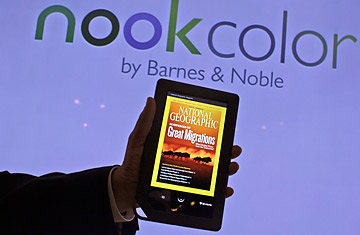
The Nook e-reader with a color touchscreen
In December 2009, brick-and-mortar book-selling powerhouse Barnes & Noble got into the e-reader game, two years after Amazon.com's Kindle jump-started the category. Its Nook had some distinguishing characteristics: you navigated the interface using a tiny color touchscreen that sat under its black-and-white E Ink display, for instance, and could loan out e-books to Nook-owning pals. Mostly, though, the gizmo felt like a twist on the Kindle formula, not a departure from it — and while it may have been fancier, it was also pokier and glitchier.
That was last year's Nook. This year's model is called the Nook Color, and its very name indicates that it's moved in a decisively un-Kindleish direction. The ungainly dual-screen E Ink/LCD interface has given way to a full-blown 7-in. color LCD touchscreen, making the Nook Color the first true color e-reader from a major company. The device is still mostly about consuming words — Barnes & Noble calls it a "reader's tablet" — but it resembles a shrunken iPad more than it resembles the Kindle, and has even more in common with Samsung's Galaxy Tab.
Unlike the Kindle and first-generation Nook, the Nook Color is available in a single model, which sports a wi-fi connection but no 3G broadband (you'll need to do your shopping and downloading within reach of a wi-fi network). It goes for $249 — more than the $139 wi-fi–only Kindle and $189 3G/wi-fi version, but dramatically less than the iPad (which starts at $499) and Galaxy Tab ($599 and up, unless you commit to a two-year wireless contract). Barnes & Noble will continue to sell the original Nook as well, at $149 for wi-fi and $199 for 3G/wi-fi.
Kindle admirers may consider Barnes & Noble's decision to ditch E Ink as technological blasphemy. It helps Amazon.com build an e-reader that's thin and light, with a glare-free screen and crazy battery life — it runs for a month on a charge, and you don't even need to worry about shutting off the screen. It's what makes the Kindle, in Amazon.com CEO Jeff Bezos's oft-repeated words, "disappear in your hands."
Even in the advanced version seen on the newest Kindle, though, E Ink isn't without sizable downsides. Amazon.com is fond of saying that it "reads like real paper," but that's true only if you're talking about light gray paper that's been printed on with dark gray ink. It isn't backlighted, so it's hard to read in murky lighting. It doesn't do color. And it refreshes so sluggishly that animation and video are impossibilities.
Compared with E Ink, the new Nook's backlight color display has one major flaw: it reduces battery life to eight hours or so, and that's with the wi-fi turned off. Me, I'll take the trade-off. Kindle partisans like to point out that E Ink is wonderfully legible at the beach in direct sunlight that would bleach out any LCD screen; Amazon.com even based a commercial on the idea. It's a reasonable point, but it has a flip side. In a darkened movie theater this weekend, bored by the endless trailers, I did something with the Nook that would have been simply impossible on the Kindle: I read.
Of course, the key advantage of a color screen is ... color. The Nook Color's on-board bookstore is launching with more than 60 magazines — not including TIME — available via single-copy purchases and subscriptions, retaining all the art, layouts and ads of their dead-tree counterparts. (The Kindle offers even more titles, but in cruder, reformatted versions; both tablets have newspapers in fairly Spartan form.) Barnes & Noble is also selling children's picture books in all their polychromatic glory, some with built-in "Read to Me" voice-overs. And its e-reader has a full-color Web browser that can play some online videos — although not ones that use Adobe's Flash Player — as well as ones you transfer from a computer via USB cable.
On both the Nook and the Kindle, most of the available reading material consists of hundreds of thousands of books with few, if any, illustrations. Precise comparisons of the selection are tricky — Barnes & Noble appears to lump scanned public-domain works into its claim of more than 2 million books, while Amazon.com doesn't include them in its count of 725,000 volumes — but both merchants offer 14 of the New York Times' 15 hardcover best sellers in both the fiction and nonfiction categories, often at $9.99. I preferred the Nook Color experience to the Kindle one for plain text, simply because the "paper" is so much whiter and the "ink" so much blacker.
